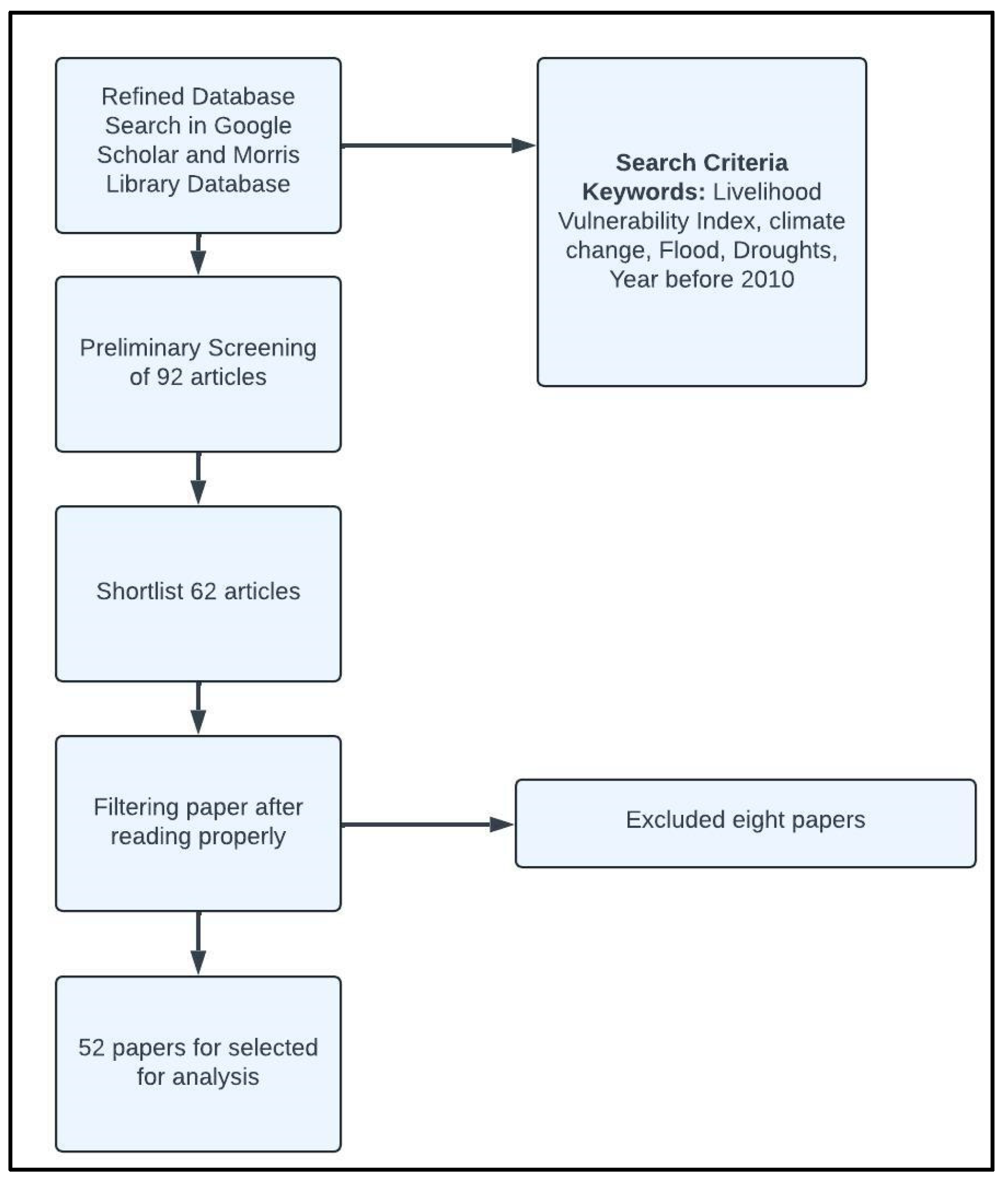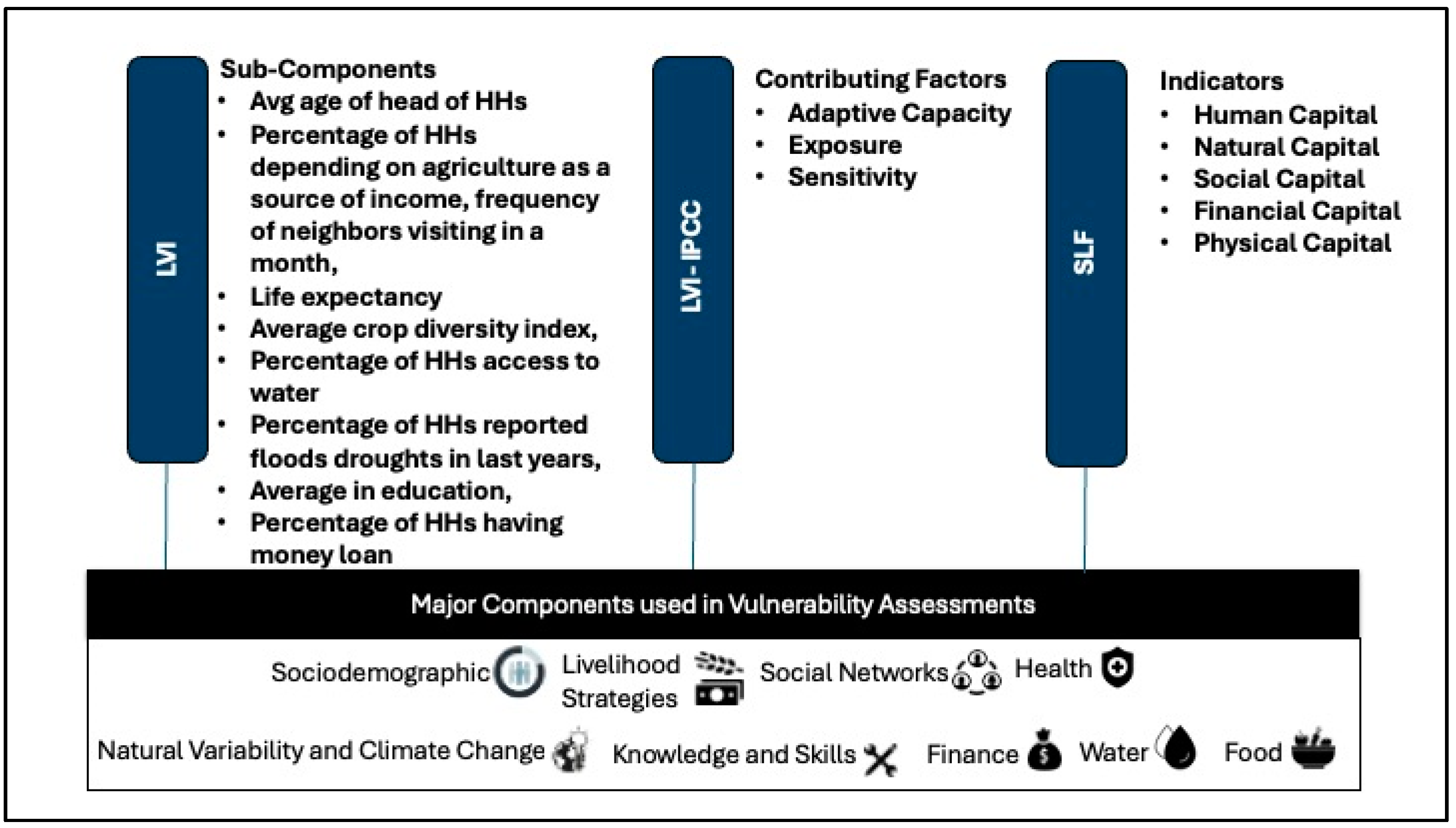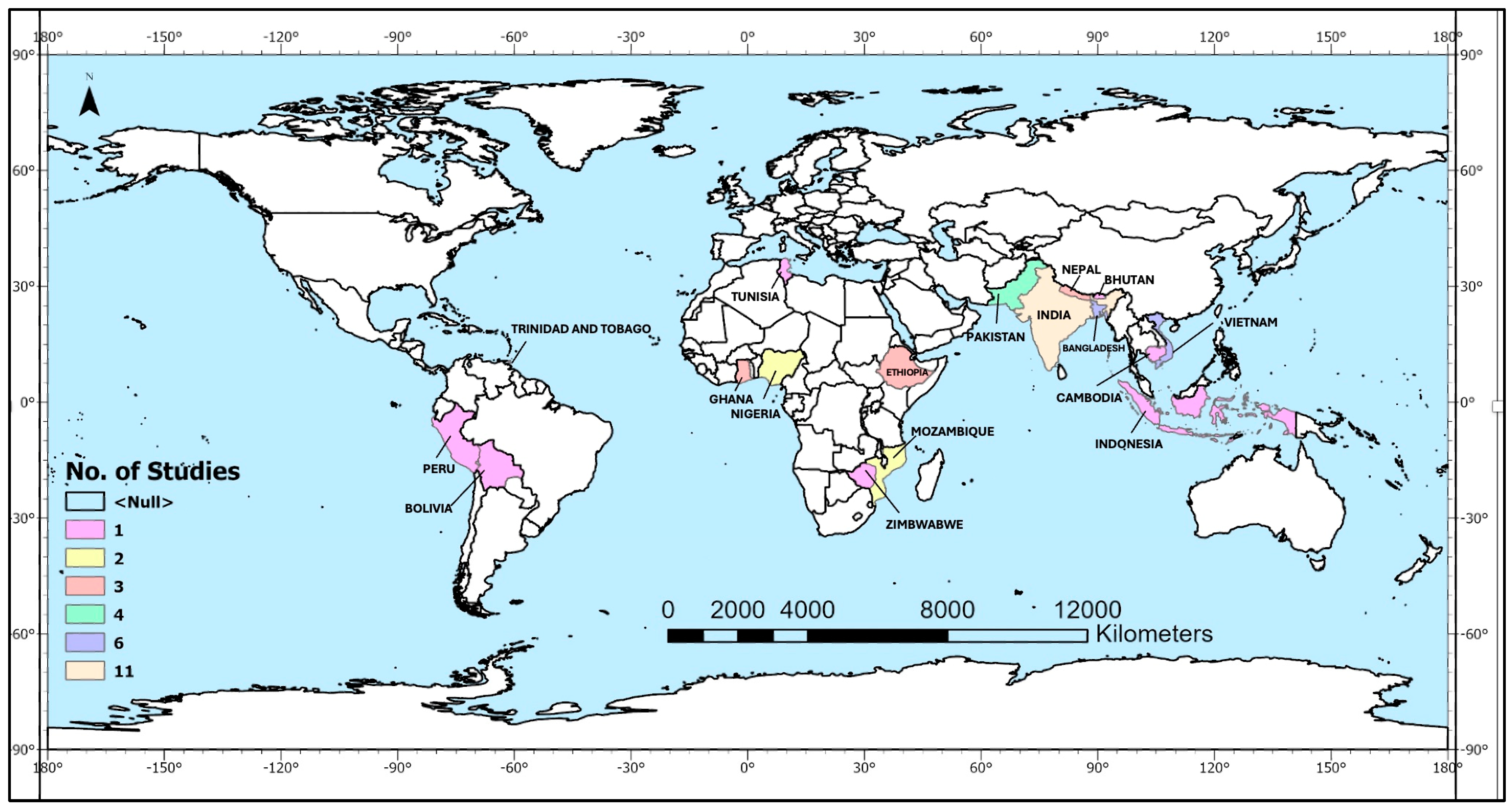Taking Stock of Recent Progress in Livelihood Vulnerability Assessments to Climate Change in the Developing World
Abstract
:1. Introduction
2. Review Approach
3. Results
3.1. Geographical Location, Scale, and Ecosystems
3.2. Frameworks
3.3. Data Collection
3.4. Key Dimensions and Components of Vulnerability
4. Discussion
4.1. Geographical Location, Scale, and Ecosystems
4.2. Vulnerability Assessment Frameworks and Methodology
5. Conclusions
6. Recommendations for Future Livelihood Vulnerability Assessments
Supplementary Materials
Author Contributions
Funding
Data Availability Statement
Conflicts of Interest
References
- UNDP. Integrating Disaster Reduction with Adaptation to Climate Change. In Proceedings of the Synthesis of UNDP Expert Group Meeting, Havana, Cuba, 17–19 June 2002. [Google Scholar]
- IPCC. Climate Change 2007: Impacts, Adaptation and Vulnerability. Contribution of Working Group II to the Fourth Assessment Report of the Intergovernmental Panel on Climate Change (IPCC); Cambridge University Press: Cambridge, UK, 2007; 976p. [Google Scholar]
- Thornton, P.K.; Ericksen, P.J.; Herrero, M.; Challinor, A.J. Climate variability and vulnerability to climate change: A review. Glob. Chang. Biol. 2014, 20, 3313–3328. [Google Scholar] [CrossRef] [PubMed]
- IPCC. Global Warming of 1.5 °C: An IPCC Special Report on the Impacts of Global Warming of 1.5 °C above Pre-Industrial Levels and Related Global Greenhouse Gas Emission Pathways; IPCC: Geneva, Switzerland, 2018. [Google Scholar]
- Muluneh, M.G. Impact of climate change on biodiversity and food security: A global perspective—A review article. Agric. Food Secur. 2021, 10, 36. [Google Scholar] [CrossRef]
- Janssen, M.A.; Schoon, M.L.; Ke, W.; Börner, K. Scholarly networks on resilience, vulnerability and adaptation within the human dimensions of global environmental change. Glob. Environ. Chang. 2006, 16, 240–252. [Google Scholar] [CrossRef]
- White, G.F. Natural Hazards; Oxford University Press: Oxford, UK; New York, NY, USA, 1974. [Google Scholar]
- Füssel, H.M.; Klein, R.J.T. Climate change vulnerability assessments: An evolution of conceptual thinking. Clim. Chang. 2006, 75, 301–329. [Google Scholar] [CrossRef]
- IPCC. Climate Change 2001: Synthesis Report. A Contribution of Working Groups I, II, and III to the Third Assessment Report of the Integovernmental Panel on Climate Change; Watson, R.T., the Core Writing Team, Eds.; Cambridge University Press: Cambridge, UK; New York, NY, USA, 2001. [Google Scholar]
- Ionescu, C.; Klein RJ, T.; Hinkel, J.; Kavi Kumar, K.S.; Klein, R. Towards a Formal Framework of Vulnerability to Climate Change. Environ. Model. Assess. 2008, 14, 1–16. [Google Scholar] [CrossRef]
- Lin, K.H.E.; Polsky, C. Indexing livelihood vulnerability to the effects of typhoons in indigenous communities in Taiwan. Geogr. J. 2015, 182, 135–152. [Google Scholar] [CrossRef]
- Ahmad, M.M.; Yaseen, M.; Saqib, S.E. Climate change impacts of drought on the livelihood of dryland smallholders: Implications of adaptation challenges. Int. J. Disaster Risk Reduct. 2022, 80, 103210. [Google Scholar] [CrossRef]
- Cruz, R.V.; Harasawa, H.; Lal, M.; Wu, S.; Anokhin, Y.; Punsalmaa, B.; Honda, Y.; Jafari, M.; Li, C.; Ninh, N.H. Asia. In Climate Change 2007: Impacts, Adaptation and Vulnerability. Contribution of Working Group II to the Fourth Assessment Report of the Intergovernmental Panel on Climate Change; Parry, M., Canziani, O., Palutikof, J., Van Der Linden, P., Hanson, C., Eds.; Cambridge University Press: Cambridge, UK, 2007; pp. 469–506. [Google Scholar]
- Nicholls, R.J.; Wong, P.P.; Burkett, V.R.; Codignotto, J.O.; Hay, J.E.; McLean, R.F.; Ragoonaden, S.; Woodroffe, C.D. 2007: Coastal systems and low-lying areas. In Climate Change 2007: Impacts, Adaptation and Vulnerability. Contribution of Working Group II to the Fourth Assessment Report of the Intergovernmental Panel on Climate Change; Parry, M.L., Canziani, O.F., Palutikof, J.P., van der Linden, P.J., Hanson, C.E., Eds.; Cambridge University Press: Cambridge, UK; pp. 315–356.
- Malone, E.L.; Engle, N.L. Evaluating regional vulnerability to climate change: Purposes and methods. WIREs Clim. Chang. 2011, 2, 462–474. [Google Scholar] [CrossRef]
- Mengist, W.; Soromessa, T.; Legese, G. Method for conducting systematic literature review and meta-analysis for environmental science research. MethodsX 2020, 7, 100777. [Google Scholar] [CrossRef]
- Pati, D.; Lorusso, L.N. How to Write a Systematic Review of the Literature. HERD Health Environ. Res. Des. J. 2017, 11, 15–30. [Google Scholar] [CrossRef]
- Carrera-Rivera, A.; Ochoa, W.; Larrinaga, F.; Lasa, G. How-to conduct a systematic literature review: A quick guide for computer science research. MethodsX 2022, 9, 101895. [Google Scholar] [CrossRef] [PubMed]
- Misra, D.P.; Agarwal, V. Systematic Reviews: Challenges for Their Justification, Related Comprehensive Searches, and Implications. J. Korean Med. Sci. 2018, 33, e92. [Google Scholar] [CrossRef] [PubMed]
- Moore, B.; Verfuerth, C.; Minas, A.M.; Tipping, C.; Mander, S.; Lorenzoni, I.; Hoolohan, C.; Jordan, A.J.; Whitmarsh, L. Transformations for climate change mitigation: A systematic review of terminology, concepts, and characteristics. WIREs Clim. Chang. 2021, 12, e738. [Google Scholar] [CrossRef]
- Sullivan, C.; Meigh, J. Targeting attention on local vulnerabilities using an integrated index approach: The example of the climate vulnerability index. Water Sci. Technol. 2005, 51, 69–78. [Google Scholar] [CrossRef] [PubMed]
- Thapa, B.; Scott, C.; Wester, P.; Varady, R. Towards characterizing the adaptive capacity of farmer-managed irrigation systems: Learnings from Nepal. Curr. Opin. Environ. Sustain. 2016, 21, 37–44. [Google Scholar] [CrossRef]
- Adger, W.N. Vulnerability. Glob. Environ. Chang. 2006, 16, 268–281. [Google Scholar] [CrossRef]
- IPCC. Climate Change 2022: Impacts, Adaptation, and Vulnerability. Contribution of Working Group II to the Sixth Assessment Report of the Intergovernmental Panel on Climate Change; Pörtner, H.-O., Roberts, D.C., Tignor, M., Poloczanska, E.S., Mintenbeck, K., Alegría, A., Craig, M., Langsdorf, S., Löschke, S., Möller, V., Eds.; Cambridge University Press: Cambridge, UK; New York, NY, USA, 2022; 3056p. [Google Scholar] [CrossRef]
- Shah, K.U.; Dulal, H.B.; Johnson, C.; Baptiste, A. Understanding livelihood vulnerability to climate change: Applying the livelihood vulnerability index in Trinidad and Tobago. Geoforum 2013, 47, 125–137. [Google Scholar] [CrossRef]
- Rehman, S.; Azhoni, A.; Chabbi, P.H. Livelihood vulnerability assessment and climate change perception analysis in Arunachal Pradesh, India. GeoJournal 2022, 88, 1427–1447. [Google Scholar] [CrossRef]
- Notenbaert, A.; Karanja, S.N.; Herrero, M.; Felisberto, M.; Moyo, S. Derivation of a household-level vulnerability index for empirically testing measures of adaptive capacity and vulnerability. Reg. Environ. Chang. 2012, 13, 459–470. [Google Scholar] [CrossRef]
- Poudel, S.; Funakawa, S.; Shinjo, H.; Mishra, B. Understanding households’ livelihood vulnerability to climate change in the Lamjung district of Nepal. Environ. Dev. Sustain. 2020, 22, 8159–8182. [Google Scholar] [CrossRef]
- Sridevi, D.G.; Jyotishi, A.; Mahapatra DS, K.; Jagadeesh, G.; Bedamatta, S. Climate Change Vulnerability in Agriculture Sector: Indexing and Mapping of Four Southern Indian States. SSRN Electron. J. 2014. [Google Scholar] [CrossRef]
- Morton, J.F. The impact of climate change on smallholder and subsistence agriculture. Proc. Natl. Acad. Sci. USA 2007, 104, 19680–19685. [Google Scholar] [CrossRef] [PubMed]
- Rigg, J.; Salamanca, A.; Thompson, E.C. The puzzle of East and Southeast Asia’s persistent smallholder. J. Rural. Stud. 2016, 43, 118–133. [Google Scholar] [CrossRef]
- Wahid, A.N.; Alam, M.M.; Talib, B.A.; Siwar, C. Climatic changes and vulnerability of household food utilisation in Malaysian East Coast Economic Region. Int. J. Environ. Sustain. Dev. 2018, 17, 331. [Google Scholar] [CrossRef]
- Ghosh, A.; Mukhopadhyay, S. Vulnerability assessment through index modeling: A case study in Muriganga-Saptamukhi estuarine interfluve, Sundarban, India. Arab. J. Geosci. 2017, 11, 179. [Google Scholar] [CrossRef]
- Eguiguren-Velepucha, P.A.; Chamba, J.A.M.; Mendoza, N.A.A.; Ojeda-Luna, T.L.; Samaniego-Rojas, N.S.; Furniss, M.J.; Howe, C.; Mendoza, Z.H.A. Tropical ecosystems vulnerability to climate change in southern Ecuador. Trop. Conserv. Sci. 2016, 9. [Google Scholar] [CrossRef]
- Mimura, N. Vulnerability of island countries in the South Pacific to sea level rise and climate change. Clim. Res. 1999, 12, 137–143. [Google Scholar] [CrossRef]
- Azam, G.; Huda, M.E.; Bhuiyan, M.A.H.; Mohinuzzaman, M.; Bodrud-Doza, M.; Islam, S.M.D. Climate Change and Natural Hazards Vulnerability of Char Land (Bar Land) Communities of Bangladesh: Application of the Livelihood Vulnerability Index (LVI). Glob. Soc. Welf. 2019, 8, 93–105. Available online: https://link.springer.com/article/10.1007/s40609-019-00148-1 (accessed on 13 December 2023). [CrossRef]
- Alam, G.M.M. Livelihood Cycle and Vulnerability of Rural Households to Climate Change and Hazards in Bangladesh. Environ. Manag. 2017, 59, 777–791. Available online: https://link.springer.com/article/10.1007/s00267-017-0826-3 (accessed on 23 January 2024). [CrossRef]
- Hoq, M.S.; Raha, S.K.; Hossain, M.I. Livelihood Vulnerability to Flood Hazard: Understanding from the Flood-prone Haor Ecosystem of Bangladesh. Environ. Manag. 2021, 67, 532–552. [Google Scholar] [CrossRef]
- Islam, M.M.; Sallu, S.; Hubacek, K.; Paavola, J. Vulnerability of fishery-based livelihoods to the impacts of climate variability and change: Insights from coastal Bangladesh. Reg. Environ. Chang. 2013, 14, 281–294. [Google Scholar] [CrossRef]
- Nguyen, T.A.; Nguyen, B.T.; Van Ta, H.; Nguyen NT, P.; Hoang, H.T.; Nguyen, Q.P.; Hens, L. Livelihood vulnerability to climate change in the mountains of Northern Vietnam: Comparing the Hmong and the Dzao ethnic minority populations. Environ. Dev. Sustain. 2021, 23, 13469–13489. [Google Scholar] [CrossRef]
- de Haan, L. Rural and urban livelihoods, social exclusion and social protection in sub-Saharan Africa. Geogr. Tidsskr. 2017, 117, 130–141. [Google Scholar] [CrossRef]
- Bérgolo, M.; Cruces, G.; Ham, A. Assessing the Predictive Power of Vulnerability Measures, Evidence from Panel Data for Argentina and Chile. J. Income Distrib. 2012, 21, 28–64. [Google Scholar] [CrossRef]
- Ali, S.I.; Ghani, A. Assessing the Impact of Climate Change on Small-Scale Fisheries Livelihood Vulnerability index. Acad. Strateg. Manag. J. 2021, 20, 1–13. [Google Scholar]
- Preston, B.L.; Westaway, R.M.; Yuen, E.J. Climate adaptation planning in practice: An evaluation of adaptation plans from three developed nations. Mitig. Adapt. Strateg. Glob. Chang. 2010, 16, 407–438. [Google Scholar] [CrossRef]
- Eriksen, S.H.; Kelly, P.M. Developing Credible Vulnerability Indicators for Climate Adaptation Policy Assessment. Mitig. Adapt. Strateg. Glob. Chang. 2006, 12, 495–524. [Google Scholar] [CrossRef]
- Chambers, R.; Conway, G. Sustainable Rural Livelihoods: Practical Concepts for the 21st Century; IDS Discussion Paper 296; IDS: Brighton, UK, 1992. [Google Scholar]
- Hahn, M.B.; Riederer, A.M.; Foster, S.O. The Livelihood Vulnerability Index: A pragmatic approach to assessing risks from climate variability and change—A case study in Mozambique. Glob. Environ. Chang. 2009, 19, 74–88. [Google Scholar] [CrossRef]
- Mekonen, A.A.; Berlie, A.B. Rural households’ livelihood vulnerability to climate variability and extremes: A livelihood zone-based approach in the Northeastern Highlands of Ethiopia. Ecol. Process. 2021, 10, 55. [Google Scholar] [CrossRef]
- Fahad, S.; Hossain, M.S.; Huong NT, L.; Nassani, A.A.; Haffar, M.; Naeem, M.R. An assessment of rural household vulnerability and resilience in natural hazards: Evidence from flood prone areas. Environ. Dev. Sustain. 2022, 25, 5561–5577. [Google Scholar] [CrossRef]
- Feindouno, S.; Guillaumont, P.; Simonet, C. The Physical Vulnerability to Climate Change Index: An Index to Be Used for International Policy. Ecol. Econ. 2020, 176, 106752. [Google Scholar] [CrossRef]
- Saikia, M.; Mahanta, R. Measurement of Vulnerability to Climate Change in Char Areas. Ecol. Econ. Soc. INSEE J. 2023, 6, 13–30. [Google Scholar] [CrossRef]
- Smith, B.; Diedrich, A. A systematic review of current progress in community based vulnerability assessments. Reg. Environ. Chang. 2024, 24, 21. [Google Scholar] [CrossRef]
- Wangmo, S.; Dorji, U.; Dorji, N. Assessing the Livelihood Vulnerability to Impact of Climate Change in Western Bhutan. J. Agric. Ecol. Res. Int. 2023, 24, 21–39. [Google Scholar] [CrossRef]
- Gravitiani, E.; Fitriana, S.N.; Suryanto, N. Community livelihood vulnerability level in northern and southern coastal area of Java, Indonesia. IOP Conference Series. Earth Environ. Sci. 2018, 202, 012050. [Google Scholar] [CrossRef]
- Rai, P.; Bajgai, Y.; Rabgyal, J.; Katwal, T.B.; Delmond, A.R. Empirical Evidence of the Livelihood Vulnerability to Climate Change Impacts: A Case of Potato-Based Mountain Farming Systems in Bhutan. Sustainability 2022, 14, 2339. [Google Scholar] [CrossRef]
- Agresti, A.; Finlay, B. Statistical Methods for the Social Sciences, Global Edition. 2018. Available online: http://books.google.ie/books?id=AS9EtAEACAAJ&dq=Statistical+Methods+for+the+Social+Sciences+5th+Edition&hl=&cd=1&source=gbs_api (accessed on 12 February 2024).
- Shimizu, I. Multistage Sampling. Encycl. Biostat. 2005. [Google Scholar] [CrossRef]



| Component | Metric Unit | Sub-Component |
|---|---|---|
| Natural Disasters and Climate Variability | Percentage |
|
| Socio-demographic Profile | Count, percentage, ratio |
|
| Livelihood Strategies | Percentage |
|
| Social Networks | Percentage |
|
| Health | Percentage |
|
| Food | Percentage |
|
| Water | Percentage |
|
| Sr No. | Vulnerability Assessment Frameworks | Description | Characteristics | Benefits | Limitations |
|---|---|---|---|---|---|
| 1. | SLF (Chambers and Conway, 1992) [46] | Analyzes livelihood resources, livelihood activities, and livelihood outcomes under the impact of external context, institutions, and policies | —People-focused and participatory —Conducted in partnership with the public and private sector —Examines natural, social, political, human, physical, and economic assets | —Enables a comprehensive understanding of the numerous stressors influencing the flow of various assets within communities —Components are well-defined and consistently utilized by researchers worldwide, making indexing with these components widely accepted —Essential for developing effective regional and global climate change initiatives | —Limited in capturing the dynamic nature of capital assets over time and requires high levels of resources and expertise to implement effectively on the ground —Focuses on the stocks of assets rather than the flow of services they provide; this is especially critical for natural capital, as the flow of services can change significantly in response to climate change without necessarily altering the overall stocks of natural capital |
| 2. | LVI Hahn et al. (2009) [47] | —Uses a balanced weighted average approach, where each sub-component contributes equally to the overall index, even though each major component of different livelihood assets is comprised of a different number of sub-components | —Composite of seven equally weighted components —Focus on local and household level —Adaptable to include indicators specific to local conditions and particular communities | —Utilizes primary data from household surveys —Valuable for planning and policymaking to prioritize and allocate natural resources to the most vulnerable populations | —Subjectivity in indicator selection —Does not account for variance between study populations —Oversimplifies a complex reality and lacks a straightforward method for validating indices composed of diverse indicators |
| 3. | LVI-IPCC Hahn et al. (2009) [47] | Derives from the IPCC vulnerability definition that characterizes vulnerability with three components: exposure, sensitivity, and adaptive capacity | —Focus on community and HH level and also at the regional level | —Provides a comprehensive understanding of livelihood vulnerability, specifically concerning flooding | —Assigns equal weights when aggregating the index values of different contributing factors of vulnerability; however, it is inappropriate to assume that all components contribute equally to vulnerability |
Disclaimer/Publisher’s Note: The statements, opinions and data contained in all publications are solely those of the individual author(s) and contributor(s) and not of MDPI and/or the editor(s). MDPI and/or the editor(s) disclaim responsibility for any injury to people or property resulting from any ideas, methods, instructions or products referred to in the content. |
© 2024 by the authors. Licensee MDPI, Basel, Switzerland. This article is an open access article distributed under the terms and conditions of the Creative Commons Attribution (CC BY) license (https://creativecommons.org/licenses/by/4.0/).
Share and Cite
Zainab, A.; Shah, K.U. Taking Stock of Recent Progress in Livelihood Vulnerability Assessments to Climate Change in the Developing World. Climate 2024, 12, 100. https://doi.org/10.3390/cli12070100
Zainab A, Shah KU. Taking Stock of Recent Progress in Livelihood Vulnerability Assessments to Climate Change in the Developing World. Climate. 2024; 12(7):100. https://doi.org/10.3390/cli12070100
Chicago/Turabian StyleZainab, Atoofa, and Kalim U. Shah. 2024. "Taking Stock of Recent Progress in Livelihood Vulnerability Assessments to Climate Change in the Developing World" Climate 12, no. 7: 100. https://doi.org/10.3390/cli12070100





